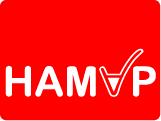HAMAP rule MF_01128
General rule information
[?]
| PURL | https://purl.expasy.org/hamap/rule/MF_01128 |
| Accession | MF_01128 |
| Dates | 28-FEB-2005 (Created)
19-NOV-2022 (Last updated, Version 32) |
| Name | CLC_ClcA |
| Scope(s) |
Bacteria |
| Template(s) | P37019; [ Recover all ] |
| Triggered by |
HAMAP; MF_01128 (Get profile general information and statistics) |
Propagated annotation
[?]
Identifier, protein and gene names
[?]
| Identifier | CLCA |
| Protein name | RecName: Full=H(+)/Cl(-) exchange transporter ClcA; |
| case <OC:Enterobacterales> | |
| Gene name | Name=clcA; Synonyms=eriC; |
| else | |
| Gene name | Name=clcA; |
| end case | |
Comments
[?]
| FUNCTION | Proton-coupled chloride transporter. Functions as antiport system and exchanges two chloride ions for 1 proton. Probably acts as an electrical shunt for an outwardly-directed proton pump that is linked to amino acid decarboxylation, as part of the extreme acid resistance (XAR) response. |
| CATALYTIC ACTIVITY | Reaction=2 chloride(in) + H(+)(out) = 2 chloride(out) + H(+)(in); Xref=Rhea:RHEA:29567, ChEBI:CHEBI:15378, ChEBI:CHEBI:17996; |
| SUBUNIT | Homodimer. |
| case not defined <Property:Membrane> or <Property:Membrane=1> | |
| SUBCELLULAR LOCATION | Cell membrane; Multi-pass membrane protein. |
| else case <Property:Membrane=2> | |
| SUBCELLULAR LOCATION | Cell inner membrane; Multi-pass membrane protein. |
| end case | |
| SIMILARITY | Belongs to the chloride channel (TC 2.A.49) family. ClcA subfamily. |
Keywords
[?]
| Antiport | |
| case defined <Property:Membrane> and <Property:Membrane=2> | |
| Cell inner membrane | |
| end case | |
| Cell membrane | |
| Chloride | |
| Ion transport | |
| Membrane | |
| Transmembrane | |
| Transport | |
| Transmembrane helix | |
Gene Ontology
[?]
| GO:0015297; Molecular function:antiporter activity |
| GO:0006821; Biological process:chloride transport |
| GO:0005886; Cellular component:plasma membrane |
Cross-references
[?]
| Pfam | PF00654; Voltage_CLC; 1; |
| PRINTS | PR00762; CLCHANNEL; 1; |
| General | Transmembrane; -; 11; |
Features
[?]
| From: CLCA_ECOLI (P37019) | ||||||||||||
| Key | From | To | Description | Tag | Condition | FTGroup | ||||||
| case defined <Property:Membrane> and <Property:Membrane=2> | ||||||||||||
| TOPO_DOM | Nter | 32 | /note="Cytoplasmic" | |||||||||
| TRANSMEM | 33 | 69 | /note="Helical" | |||||||||
| TOPO_DOM | 70 | 76 | /note="Periplasmic" | |||||||||
| TRANSMEM | 77 | 100 | /note="Helical" | |||||||||
| INTRAMEM | 109 | 116 | /note="Helical" | |||||||||
| TOPO_DOM | 117 | 123 | /note="Cytoplasmic" | |||||||||
| TRANSMEM | 124 | 141 | /note="Helical" | |||||||||
| TRANSMEM | 148 | 166 | /note="Helical" | |||||||||
| TOPO_DOM | 167 | 176 | /note="Cytoplasmic" | |||||||||
| INTRAMEM | 177 | 189 | /note="Helical" | |||||||||
| INTRAMEM | 193 | 201 | /note="Helical" | |||||||||
| TOPO_DOM | 202 | 214 | /note="Cytoplasmic" | |||||||||
| TRANSMEM | 215 | 232 | /note="Helical" | |||||||||
| TOPO_DOM | 233 | 252 | /note="Periplasmic" | |||||||||
| TRANSMEM | 253 | 281 | /note="Helical" | |||||||||
| TOPO_DOM | 282 | 287 | /note="Cytoplasmic" | |||||||||
| TRANSMEM | 288 | 309 | /note="Helical" | |||||||||
| TOPO_DOM | 310 | 329 | /note="Periplasmic" | |||||||||
| TRANSMEM | 330 | 349 | /note="Helical" | |||||||||
| TRANSMEM | 355 | 376 | /note="Helical" | |||||||||
| TOPO_DOM | 377 | 386 | /note="Periplasmic" | |||||||||
| INTRAMEM | 387 | 401 | /note="Helical" | |||||||||
| INTRAMEM | 402 | 404 | /note="Note=Loop between two helices" | |||||||||
| INTRAMEM | 405 | 416 | /note="Helical" | |||||||||
| INTRAMEM | 417 | 421 | /note="Note=Loop between two helices" | |||||||||
| TRANSMEM | 422 | 438 | /note="Helical" | |||||||||
| TOPO_DOM | 439 | Cter | /note="Cytoplasmic" | |||||||||
| MOTIF | 106 | 110 | /note="Selectivity filter part_1" | |||||||||
| MOTIF | 146 | 150 | /note="Selectivity filter part_2" | |||||||||
| MOTIF | 355 | 359 | /note="Selectivity filter part_3" | |||||||||
| end case | ||||||||||||
| BINDING | 107 | 107 | /ligand="chloride" /ligand_id="ChEBI:CHEBI:17996" |
S | ||||||||
| BINDING | 356 | 356 | /ligand="chloride" /ligand_id="ChEBI:CHEBI:17996" |
I | ||||||||
| BINDING | 357 | 357 | /ligand="chloride" /ligand_id="ChEBI:CHEBI:17996" |
F | ||||||||
| BINDING | 445 | 445 | /ligand="chloride" /ligand_id="ChEBI:CHEBI:17996" |
Y | ||||||||
| SITE | 148 | 148 | /note="Mediates proton transfer from the outer aqueous phase to the interior of the protein; involved in linking H(+) and Cl(-) transport" | E | ||||||||
| SITE | 203 | 203 | /note="Mediates proton transfer from the protein to the inner aqueous phase" | E | ||||||||
Additional information
[?]
| Size range | 467-478 amino acids |
| Related rules |
None |
| Fusion | Nter: None Cter: None |
| Comments | ClcA from E.coli was originally characterized as a voltage-gated chloride channel. It has now become clear that it is, in fact, a transporter. E.coli has at least one paralog, ClcB, and maybe YfeO, for which there is no electrophysiological characterization - they may or may not be transporters too. This family of proteins with high similarity to ClcA have, therefore, been considered as transporters as well. Further characterization is needed to distinguish ion channels from transporters, as it seems that the structural boundary separating channels and transporters is not as clear-cut as generally thought. |
